Leonora Carrington – 6 April 1917 – 25 May 2011
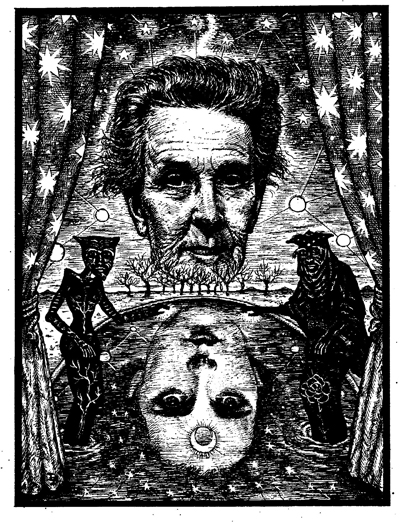
Fantastic pen and ink double portrait by Hilus Anendorf
Leonora Carrington lived a life as surreal and fantastical as the images she painted. The last of the first generation of Surrealists, she consorted with the full pantheon of greats, from Dali to Picasso, and was hailed as “Mexico’s greatest living artist” before her death 94. Despite her storied career as bohemian darling, wild muse and prolific creator of paintings, books, sculpture and theater, she remained always humble, and resolutely uninterested in labels, or all the laurels that have been flung her way over the years.
Her approach to art was completely intuitive, stemming from the deep well of her soul, her own psychic underworld realm that she populated with fantastic beasts and mysterious figures. She disdained the overintellectualization and analysis of her work, her beliefs, her inspirations – believing fervently that the visual world she created was unnecessarily hindered by those determined to understand what it was all about. She was a provocateur, delighting in stirring up trouble amongst the staid, society types whose ilk she rejected. André Breton wrote of her in his Anthologie de l’humoir noir:
“Those respectable people who, for a dozen years, had invited her to dine in a prestigious restaurant have still not recovered from the embarrassment when they noticed that, while continuing to take part in the conversation, she had taken off her shoes and meticulously covered her feet in mustard.”
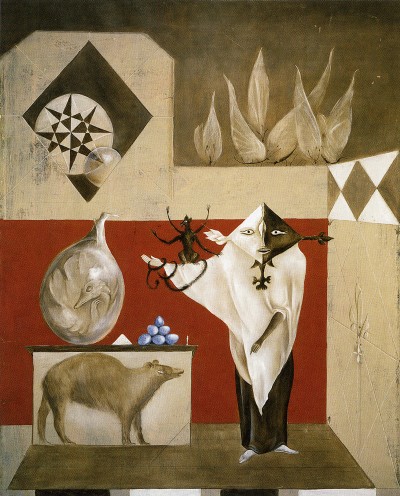
The Conjuror
All of her work is infused with this dark sense of humor and mischief, particularly her writing. In her only novel, The Hearing Trumpet, she envisions herself as a wizened crone – the 92 year old Marian Leatherby, a deaf and toothless “drooling sack of decomposing flesh” who is cast-off by callous relatives to a sanatorium for the elderly. It is here that her life truly begins, when she finds her kind: a coven of witch-sisters who help her discover and unleash her mediumistic talents.
Carrington once said, “I wanted to appear like an old lady so I could poke fun at sinister things.” As a young woman growing up in her stultifyingly proper Lancashire family estate, she railed against convention, and was booted out of multiple boarding schools. In her story “The Debutante”, she recounts her fantasy of dressing up a hyena in her coming-out dress, and sending the wild thing to her debutante’s ball in her stead. Allowed at last to attend art school, she horrified her family by running off with a married man twice her age, who happened to be Max Ernst. The romance was tragic, and ill-fated – doomed by the Nazi invasion of France and their subsequent incarceration of her lover. After a nervous breakdown, which caused her to be thrown into an asylum, she fled Europe for Mexico, where she settled and flourished until her death.
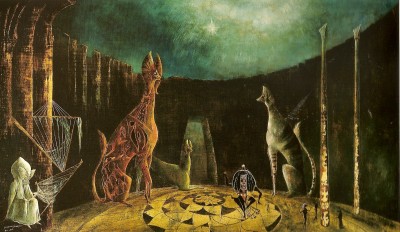
“We went down into the silent garden. Dawn is the time when nothing breathes, the hour of silence. Everything is transfixed, only the light moves.”
— Leonora Carrington
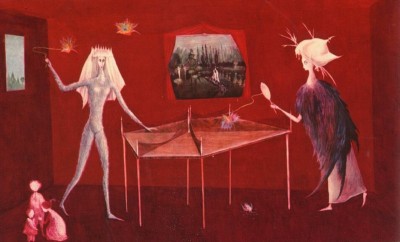
“You may not believe in magic, but something very strange is happening at this very moment. Your head has dissolved into thin air and I can see the rhododendrons through your stomach. It’s not that you are dead or anything dramatic like that, it is simply that you are fading away and I can’t even remember your name.”
— Leonora Carrington (The Hearing Trumpet)
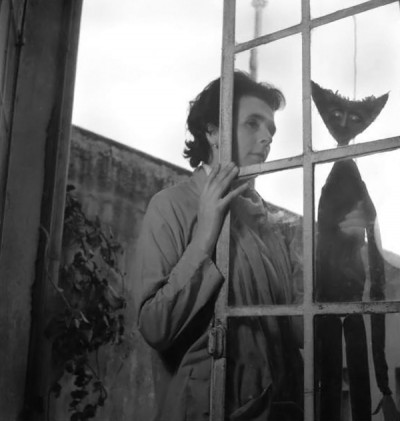
Portrait by Kati Horna, the Hungarian photographer, and Leonora’s oldest friend.
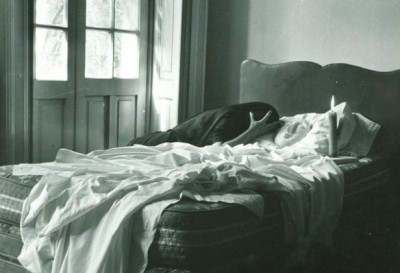
A collaboration with Horna: “Ode to necrophilia” – An apt image, for all who are mourning her now, though hopefully she is reunited with her sister Surrealists in some paradisiacal underworld, frolicking wildly with “those European bitches” which was how Frida Kahlo used to refer to Leonora, Kati and Remedios Varo. Ha!

A scene from Penelope, a play by Carrington and staged by her friend and disciple, Alejandro Jodorowsky, in 1957. Set designs/costumes by Carrington.
Leonora Carrington’s art and writings were influenced and inspired directly by her work as a magician – as a walker between worlds: an alchemist and visionary. Her world was suffused with the esoteric, and she ruled at its center, inscribing her arcane symbols onto canvas, paper, the walls of her home. Helen Byatt, in her introduction to The Hearing Trumpet describes her workspace: “One visitor to her studio called it ‘the most dream-saturated place I know,’ whilst another described her study, with its apocalyptic disorder of boxes and jars overflowing with aromatics and spices, the dusty books, pictures of fantastic animals with human eyes, and the strange dolls with birds’ heads hanging from the ceiling, as the den of a ‘sixteenth century magician.'”
In the late 50’s, instructed by their mutual friend and spiritual teacher, a Zen Buddhist monk name Ejo Takata, the filmmaker Alejandro Jodorowsky sought out Carrington in Mexico City. Their immediate connection was profound, and it seems that their interactions during this period influenced them both deeply. He writes about their meeting in his memoir, The Spiritual Journey of Alejandro Jodorowsky:
“That night I could not sleep. It was three o’clock in the morning, and my eyes were wide open. I was possessed. I could feel this woman in my blood, like a boat moving upstream. “Come, come,” she was saying with a voice that seemed to emerge from a distant past. I got dressed, went outside, ran through the streets until I was out of breath, and arrived at her house, opening the door silently with my key and making no noise on the stairs. From the room that served as her painting studio, I saw the flickering light of a candle and heard her voice reciting a litany. Edra, the watchdog, wagged her tail and let me pass without growling. I saw Leonora seated on wooden throne whose back was carved with the bust of an angel. Naked except for a Jewish prayer shawl, her gaze fixed, unblinking, and focused on infinity, she seemed like a figure on the prow of a ship from an ancient civilization. She had left the world of the rational. She continued to recite in English, taking no notice of my presence. I sat on the floor, facing her. There was little left of any individuality in her. She seemed possessed simultaneously by all women who had ever existed. The words poured out of her mouth like an endless river of invisible insects. I remember a few of her verses:
I, the eye that sees nine different worlds and tells the tale of each.
I, Anuba who saw the guts of the pharaoh, embalmer, outcast.
I, the lion goddess who ate the ancestors and churned them to gold in her belly.
I, the lunatic and fool, meat for worse fools than I.
I, the bitch of Sirius, landed here from the terrible hyperbole to howl at the moon.
I, the bamboo in the hand of Huang Po.
I, the queen bee in the entrails of Samson’s dead lion.
I, the tears of the archangel that melted it again.
I, the solitary joke made by the snow queen in higher mathematics.
I, the gypsy who brought the first greasy tarot from Venus.
I, the tree of wisdom whose thirteen branches lead eternally back again.
I, the eleventh commandment: Thou shalt despise no being.“
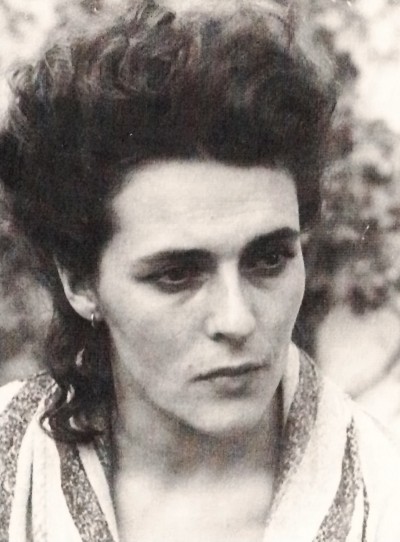
A beautiful portrait of Leonora, taken by Jodorowsky.
“One has to be careful what one takes when one goes away forever.”
— Leonora Carrington (The Hearing Trumpet)
Please take a moment and watch out this gorgeous video excerpted from the film Gifted Beauties. The animations by Gustav Kvall are wonderful, as is the music from Maia Urstad. (Ragg Film, 2000),

May 27th, 2011 at 1:54 pm
Just read it in the Times. I was hoping someone else noticed. Thanks A, this was wonderful. You’re always on it.
~Andi
May 27th, 2011 at 2:28 pm
SO on it. I love this memento mori, Angeliska, dear. Lovely. Thank you for taking the time to write it.
May 27th, 2011 at 8:19 pm
wow – this is beautiful!! thanks for the share!!!
May 28th, 2011 at 5:32 am
Beautifully done. This is exactly the kind of thing I read Coilhouse for. My world is richer for knowing of this artist. Many many thanks to the author.
May 28th, 2011 at 12:41 pm
I remember reading about Leonora and Alejandro in Arthur a few years ago, and being transfixed by the depiction of their relationship. She’s an inspiration, and I wouldn’t mind growing up to be like her. Resto en paz, Leonora.
May 29th, 2011 at 6:25 am
Thanks so much for this post. Miss Carrington was one hell of a woman. If you can track it down somewhere there was a profile of her by the British Arts show Omnibus in the nineties called ‘Leonora Carrington and the House of Fear’ which is probably the most definitive televisual portrait we’ll ever see. With any luck it’ll be repeated as a memorial.
June 1st, 2011 at 7:32 pm
The link to the video excerpt from ‘Gifted Beauties’ takes you to the Norwegian film institutes sight. I can’t seem to located a video excerpt on that site. Any leads?
Thanks and thank you for the article!
June 2nd, 2011 at 12:41 pm
Steve – sorry, we had some trouble getting the Vimeo video to link. The link to the video excerpt is below, and reads: Leonora Carrington by Pamela Robertson-Pearce – http://vimeo.com/10760131
Sorry for the confusion!
August 11th, 2011 at 7:08 am
This is essential reading !! Thanks so much !!